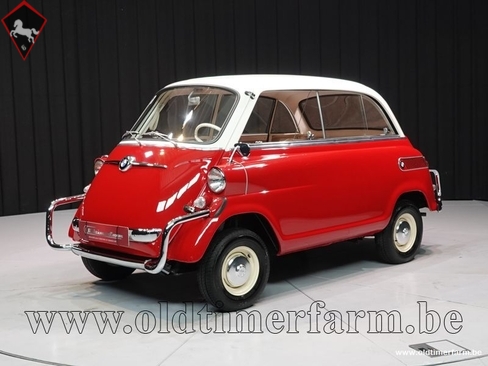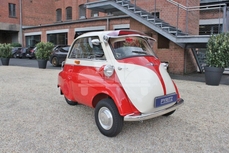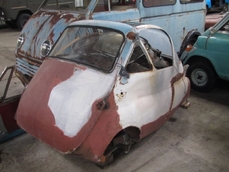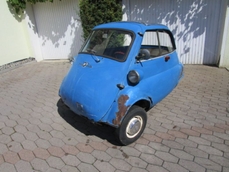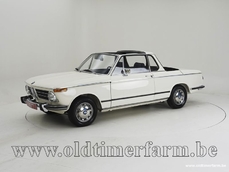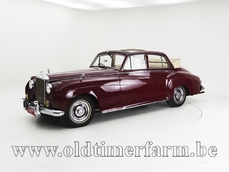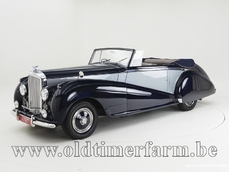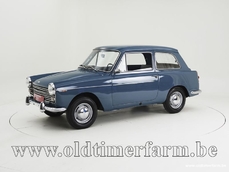BMW Isetta 600 '58 1958
General description :
Dutch papers Valuation report The Isetta is an Italian-designed microcar built under license in a number of different countries, including Argentina, Spain, Belgium, France, Brazil,Germany, and the United Kingdom. Because of its egg shape, it became known as a bubble car, a name also given to other similar vehicles. In 1955, the BMW Isetta became the world's first mass-production car to achieve a fuel consumption of 3 L/100 km. It was the top-selling single-cylinder car in the world, with 161,728 units sold. The name Isetta is the diminutive of Iso. BMW made the Isetta its own. They redesigned the powerplant around a BMW one-cylinder, four-stroke, 247 cc motorcycle engine which generated 9 kW (12 hp). Although the major elements of the Italian design remained intact, BMW re-engineered much of the car, so much so that none of the parts between a BMW Isetta Moto Coupe and an Iso Isetta are interchangeable. The first BMW Isetta appeared in April 1955. In May 1962, three years after launching the conventionally modern-looking BMW 700, BMW ceased production of Isettas. A total of 161,728 units had been built. The Isetta 250 used the engine of the morocycle R25/3. The advantage of that microcar : it could be driven with a motorcycle license in Germany.. The top speed of the Isetta 250 was rated as 85 km/h (53 mph). The Isetta 600 (presented by Oldtimerfarm)) was a larger variant with two rear doors and the rear wheels further apart. The car was more expensive and therefore not a commercial success. More than 30,000 copies of this version were made in the years 1957-1959. Velam in France and Romi in Brailia produced Isettas under license. Dewrg cars, however, seemed to be in danger of extinction since the 1970s, but at the end of the century they found a revival in the form of the Smart and the Renault, although strictly speaking these are not midget cars. Specifications Bodywork Length : cm/in: 295/116 Width : cm/in: 137/54 Height : cm/in: 142/56 Wheelbase : cm/in : 193/76 Weight: kg/lb : 510/1124 Displacement : flat-2 585 cc , rear-mounted Valve gear : 4 Fuel system : 1 Solex carburettor Gearbox : 4-speed manual Driving wheels : rear wheel drive Maximum power : 19 bhp at 4000 rpm Torque : 39 Nm at 2500 rpm
http://www.oldtimerfarm.be/en/collection-cars-for-sale/6252/bmw-isetta-600-58.php
1958 BMW Isetta 600 '58 is listed sold on ClassicDigest in Aalter by Oldtimerfarm Dealer for €39950.
Car Facts
Car type : Car Make : BMW Model : Isetta Model Version : 600 '58 Engine size : 0.0 Model Year : 1958 Location : Aalter
Sold
Seller Information
Sold
People who viewed this BMW Isetta also viewed similar BMW listed at ClassicDigest
Other cars listed for sale by this dealer
About BMW
ChatGPT
Bayerische Motoren Werke, commonly known as BMW, has a rich history dating back to its founding in 1916. Initially established as an aircraft-engine manufacturer during World War I, BMW faced restrictions on aircraft production after the war. In response, the company shifted its focus to motorcycle production in 1923, marking the beginning of its involvement in the automotive industry. Subsequently, BMW entered the world of automobiles in 1928 by producing the DIXI, essentially a licensed version of the Austin 7 from the Austin Motor Company.
In the 1930s, BMW began to establish itself as a manufacturer of elegant and high-performance vehicles. One notable model from this era is the BMW 327, introduced in 1937. The 327 was available as both a coupe and a cabriolet, showcasing the brand's commitment to luxury and style. Additionally, BMW achieved success in sports car racing during this period, particularly with the BMW 328. The 328, which debuted in 1936, became renowned for its performance and aerodynamics. BMW campaigned the 328 in various racing events, including the prestigious Mille Miglia, where the company introduced several aerodynamic specials.
The post-war era proved challenging for BMW, and the company faced financial difficulties that nearly led to bankruptcy. However, BMW managed to recover and rebuild, eventually becoming one of the leading premium automotive brands globally.
As the 1960s unfolded, BMW further solidified its reputation for producing sports-oriented and luxurious vehicles. In 1968, the BMW 2002 was introduced, marking the birth of the "New Class" of compact, sporty sedans. The 2002 gained popularity for its agile handling and performance, laying the foundation for BMW's sporty image.
Moving into the 1970s, BMW expanded its lineup with the introduction of the E9 platform, which included the iconic BMW 3.0 CS coupe. The E9 series showcased BMW's commitment to blending performance and luxury. In 1972, the M1, BMW's first mid-engined sports car, made its debut. The M1 was initially developed as a racing car but later became a road-going model. The M1 laid the groundwork for BMW's high-performance M series.
In the late 1970s, the BMW E24 6 Series was introduced, offering a combination of luxury and performance. The 6 Series included models like the 630CS, 633CSi, and 635CSi, becoming a symbol of sophistication and driving pleasure.
Through these milestones and a commitment to innovation and performance, BMW has evolved into a powerhouse in the automotive industry, maintaining its status as one of the leading premium brands worldwide.
